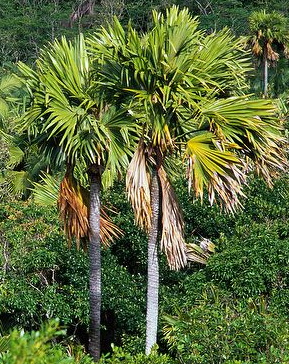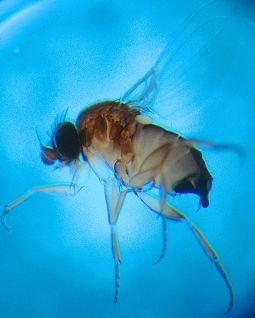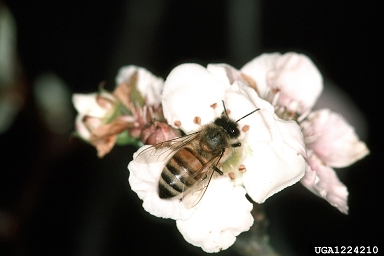
Interactions
When one thinks of a bee, the thought of a
flower is almost never far behind. The mutualistic relationship
between a bee and flower is one of the most well known in biology.
Bees obtain two necessary food components from flowers. One being
nectar to provide carbohydrates for energy and the second is pollen,
providing protein to feed the larvae. Because of this, they are
completely dependent on plants for food (Schaafsma 2006). However,
in return for nectar and pollen the bee is a very important
contributor to the plants self-pollination and cross-pollination.
Consequently, stingless bees are more successful at self-pollination
than cross-pollination due to the strictness and consistency of the
paths they travel when collecting pollen (Ramalho 2004).
Stingless
bees focus on collecting pollen from flowers with mass-flowering,
meaning that one plant produces many flowers for a short time, about
one week (Schaffsma 2006). Ramalho observed in the Brazilian
Tropical Atlantic Rainforest that the trees most visited were
melittophilous trees, small, inconspicious, generalized
mass-flowering plants found at the highest level of the forest, in
the canopy and lianas such as the
Coco-de-mer tree. Most of the plants they pollinate from were
hermaphroditic or monoecious (Ramalho 2004). Hermaphroditic and
monoecious meaning that both the female and male reproductive organs
reside on the same plant. The advantage of
getting pollen from mass-flowering plants is that it allows bees to
store great amounts of pollen and nectar at one time during good
foraging conditions, however, this is inevitably followed by a
period of bad foraging conditions. Melipona beecheii do have the
ability to adjust their foraging behavior depending on the
conditions of the mass-flowering plants (Schaffsma 2006).
When pollen
reserves get low, the number of larvae produced decreases as well as
a decreased chance of phorid fly attack on the hive (Schaffsma
2006). The phorid fly is the biggest parasite of stingless bees in
Central and South America due to the great mortality it causes a
hive. The fly is attracted to the stored food and larvae. The
invasion begins with the females, not any males, who enter the nest
and feed on pollen and lay eggs on the
 pollen stores and the waste.
When the pollen stores run low they begin laying eggs on the bee
larvae. The fly larvae feed on the bees' food and become facultative
predators (Robroek 2003). A facultative predator is an insect
predator feeds on plants or prey that is at the same developmental
stage as them (Albajes 2013). After the fly larvae pupate they
travel to a dry portion of the nest and shortly after exit the hive
without ovipositing. The only damage done to the hive was by the
initial female ovipositing. Their offspring do not have enough food
to successfully grow offspring in the same hive after the females
invaded (Robroek 2003).
pollen stores and the waste.
When the pollen stores run low they begin laying eggs on the bee
larvae. The fly larvae feed on the bees' food and become facultative
predators (Robroek 2003). A facultative predator is an insect
predator feeds on plants or prey that is at the same developmental
stage as them (Albajes 2013). After the fly larvae pupate they
travel to a dry portion of the nest and shortly after exit the hive
without ovipositing. The only damage done to the hive was by the
initial female ovipositing. Their offspring do not have enough food
to successfully grow offspring in the same hive after the females
invaded (Robroek 2003).
In addition
to dealing with the phorid flies, the M. beecheii must compete with
European and Africanized honeybees to survive. Because they produce
more honey, beekeepers prefer to rear them instead. This is part of
the problem causing them to endangerment, with no help from
deforestation and hurricanes. Part of the transition to European and
Africanized bees is due mostly to behavioral differences. European
bees wake at five o' clock in the morning to begin working and Africanized bees may work
through the night during a full moon. In contrast, M. beecheii begin
working at noon, inevitably contributing to less production of honey
(Bellows 2012). M. beecheii is also in competition with the African
and European bees for floral resources and nesting sites. In addition, the great amounts of deforestation of the Yucatan
peninsula turning the forest into agave, sisal, and cattling
ranching land instead causes the bee to forage on secondary growth
plants instead (Villanueva-G 2005).
addition, the great amounts of deforestation of the Yucatan
peninsula turning the forest into agave, sisal, and cattling
ranching land instead causes the bee to forage on secondary growth
plants instead (Villanueva-G 2005).
With all of
the organisms M. beecheii has to deal with, it has had to work with
one more for centuries and that organism is humans (EOL 2012).The
Mayans have had a beekeeping tradition dating back centuries for
spiritual reason. M. beecheii was said to have mystical power and
were messengers between the living and dead worlds. Mayans
worshipped the bee god, Ah Muzen Cab (the Descending God and Divine
God) for survival (Bellows 2012). M. beecheii is also named
“xunan-kab” bee, meaning the royal lady bee, or “cole-kab” by their
keepers. Maya used this bee to “find their place in the universe and
relationship to the earth, dieties, and Spanish invaders” (cite
quote from Villanueva-G) This bee was a gift from the gods and
handled with reverence and care. They even have a ritual called the
U-Hanli-Cab ritual where the Mayan priests ask the gods for
permission to harvest the honey (Villanueva-G 2005). M.
beecheii was not only valued for its religious and spiritual uses
but also for its use as medicine to treat infections, asthma,
dryness and cataracts. The economy benefited from it as well through
trade between other towns as well as being used to make balche.
Balche is a sacred wine made from fermented tree bark and the first
extraction of honey. Permission from the Melipona gods is needed in
order to share it (Bellows 2012). To discover more about the
Melipona beecheii and their relationship with the Mayans please
watch the short film below by Stephen Buchmann.